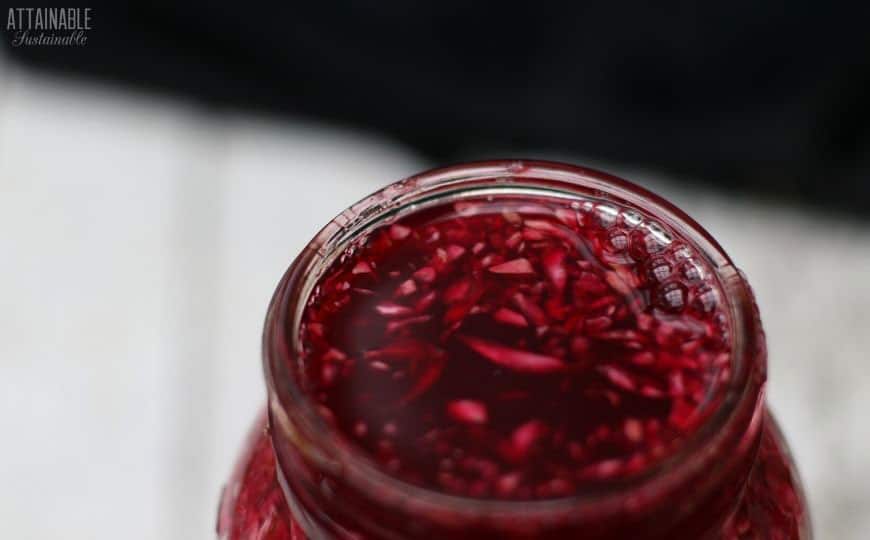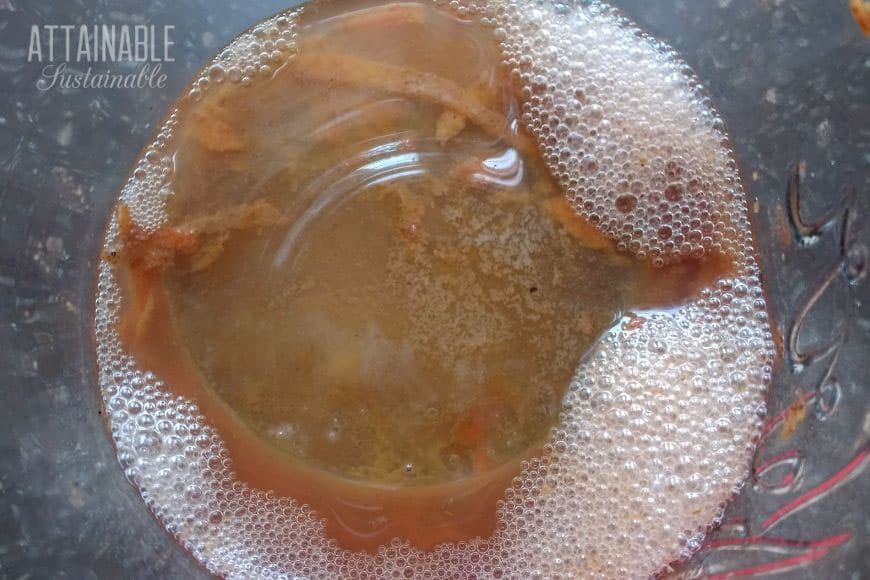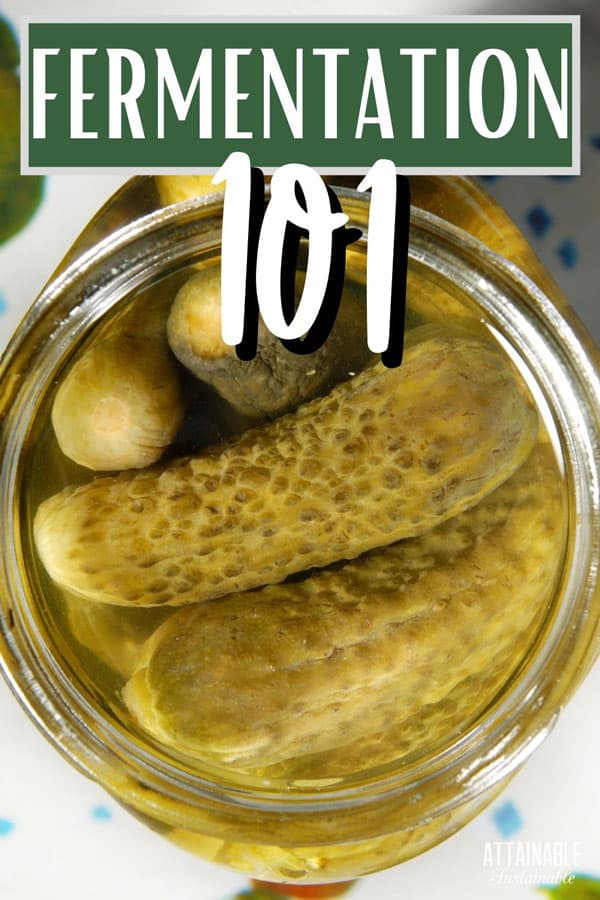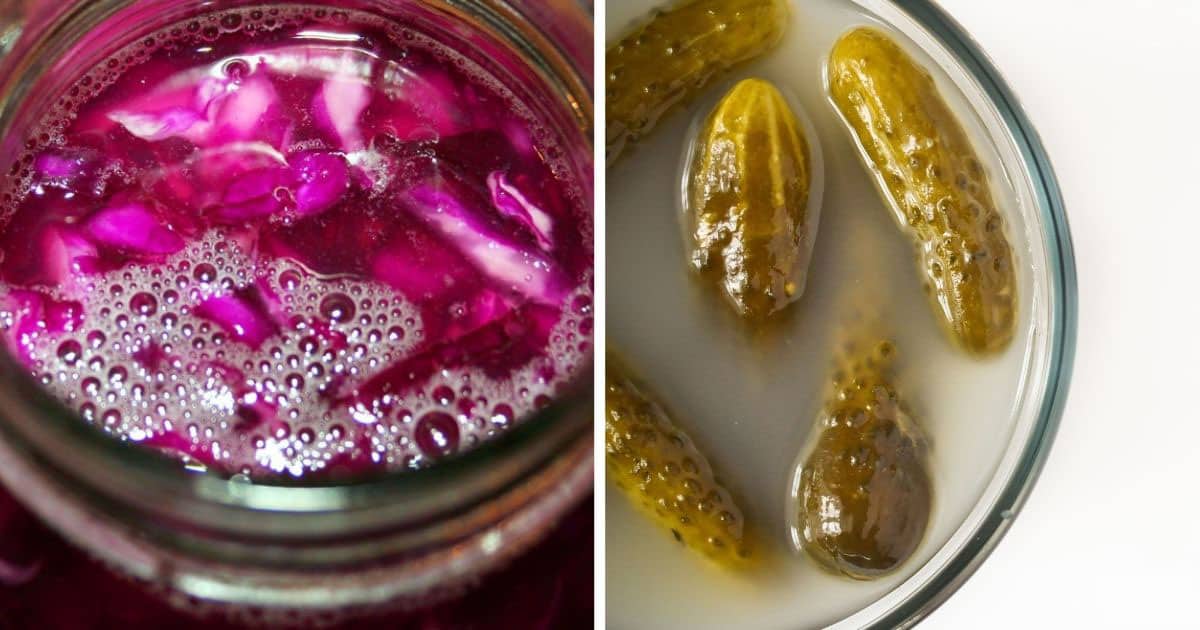Are you ready to dive into fermentation? It’s an easy way to preserve fresh produce, but the process can sound a bit intimidating (it’s not!). Read on for more about the fermentation of vegetables and fruits.
Originally published February 2021; this post has been updated.
What is Fermentation?
Fermentation is the process used to create beer and wine. That’s often what people think of when they hear the word. Those beverages are produced with yeast, though, as is this strawberry mead.
There are a few types of fermentation, but we’ll focus here on lacto-fermentation, in which we help lactic acid bacteria (LAB) thrive.
Lacto-fermentation is the process used when we make fermented vegetables, fruits, and even kombucha. Lactobacillus bacteria converts sugars into lactic acid. This good bacteria inhibits the growth of harmful bacteria. The lactobacillus organisms that develop when we ferment food preserves it, but it’s also a boon to our digestive tract. This lactic acid fermentation provides us with the probiotics that we’ve heard so much about in recent years.
Two Fermentation Methods
When fermenting foods, you’ll choose between a brine method and dry salting.
5 Easy Steps to Transform Your Pantry!
Ready to switch from store bought to homemade? Let me help you make some changes! Grab my FREE five-part guide to getting started.
The brine method calls for covering fresh vegetables such as carrot sticks or green beans with a mixture of salt and water. This is most commonly used with whole vegetables or those cut into chunks. Fermented nasturtium seeds and sugar snap peas are an example of this process.
Other ferments like this beet sauerkraut or these fermented carrots call for shredding produce and tossing it with salt. The salt causes the vegetables to release their juices. This finely chopped or shredded mixture is pressed and pounded into a jar, removing any oxygen and generating liquid. When a jar is packed full, there’s sufficient liquid to cover the solids, thus preserving them in an oxygen-free environment.
Fermentation FAQs: Equipment
What kind of jar should I use?
Any kind of glass jar will work. You don’t need a mason jar; upcycle a jar that came from the grocery store. You definitely don’t want to use a swing-top jar with the bail wire. They’re beautiful, but the metal will corrode and rust quickly thanks to the salt content in ferments. Note that most fermentation weights require a wide mouth jar.
What kind of lid should I use during fermentation?
There are a wide variety of options! There are special fermentation lids that range from an airlock (like you’d use in brewing ale) or a silicone lid called “pickle pipes.” These products automatically vent the gas that builds up with fermentation.
These specialty items can be convenient during the fermentation process, but they aren’t strictly necessary. You can use the lid that your jar came with, too. Screw it on finger tight and remember to check it daily to “burp” the gasses that accumulate. Do not leave lids so loose that fruit flies can access the brine. They will ruin a good ferment.
The Handcrafted Pantry

Ready to DIY your pantry with more wholesome ingredients? Check out my ebook, The Handcrafted Pantry! Filled with delicious recipes for some of your favorite condiments, snacks, and toppings, it’s the guide you need to start skipping packaged products and embrace homemade.
What kind of lid should I use for storing my fermented products?
Metal lids rust easily when used for salty ferments. If possible, use a plastic lid. If the upcycled jar you’re using has a metal lid, put a piece of waxed paper over the rim of the jar before screwing the lid on to prevent this.
What can I use to pound a ferment?
It’s important to pack foods like sauerkraut tightly in a jar. Your hands alone are likely not enough. I’ve used the end of a heavy wooden spoon (not ideal) and a length of a large wooden dowel – the kind that is used as a closet rod. This tamper is specifically designed for packing ferments.
Fermentation FAQs: Making the Ferment
What is a brine?
A brine is a mixture of water and salt. It’s poured over large pieces of vegetables or fruits.
What kind of water should I use?
What kind of salt should i use?
Sea salt is your best bet. Avoid pickling salt, iodized salt, or any salt with an anti-caking agent.
What kind of produce can I ferment?
So. Many. Options! You can ferment vegetables like snap peas, cauliflower, and radishes. Or fruit like pineapple. You can make sauerkraut with cabbage or even beet greens. Check out the long list of options here.
Do I need a starter culture?
Not necessarily. Adding some of the leftover brine from another ferment can help to kickstart a new recipe. If you don’t have fermented foods on hand from which you can get some brine, it’s not a problem. Your ferment will still do what it’s supposed to; you will just have to be a little bit more patient.
How much headspace should I leave?
I aim for between 1/2″ and an inch. Any more than that leaves too much oxygen in the jar and potential for contamination.
How can I keep the vegetables submerged?
I use glass weights like these when fermenting vegetables. Once your jar is packed, set a glass weight on top of the solids and push it down. The liquid level should rise above the weight. These weights fit in a wide mouth jar; they’re too big for a jar with a narrower mouth.
There are other solutions, though I find the weights to be the easiest.
- A big leaf of cabbage or carrot can be wedged across the top to hold down the solids.
- A small glass jar (like a baby food jar) filled with water.
- A small ramekin or dish plate works if you’re fermenting in a crock or larger container.
What if the brine level drops?
This can happen! An active ferment can overflow, leaving produce exposed to air. Keep an eye out for this. If you see this happening, simply add a little bit of brine to the jar, to bring the liquid level back to where it was.
You don’t have to throw out a ferment that has had a little exposure to oxygen, but remedy the problem as quickly as you can to avoid mold.
The brine is bubbling – is this okay?
Yes! This means that the ferment is very active. It will likely bubble for a day or two then settle down.
The brine is not bubbling – is this okay?
Yes! Bubbles are not mandatory for successfully fermented veggies. I find that in cooler weather, my ferments are a bit slower. They can take longer to be ready and oftentimes there’s not much bubbling if any. Those bacteria are still there doing the work, though!
How long does it take for a ferment to be ready?
It depends. The warmer the room temperature, the more active a ferment will be, generally speaking. Usually anywhere from 3-10 days will suffice. That said, if you forget to check and a fermented product sits out for an extra day or two, no harm will be done as long as the produce remains covered with brine.
Fermentation FAQs: Troubleshooting
The brine cloudy — is this okay?
Yes! This is totally normal.
How can I tell if a fermented item is good or bad?
This is a common question and one that is hard to answer. Fermenting foods will cause them to become more acidic. They should register at 4.6 pH or lower. (A pH above 4.6 means that the mixture could harbor botulism spores.)
Use pH paper to test the acidity. If it falls within those safe guidelines, give it a sniff. The nose knows! A sour smell is normal. An offensive odor is not. If it smells tangy and, well, fermented, that’s a great sign. As you gain experience, you’ll know right away when the ferment smells just right!
Next step: Take a small bite. If it tastes good and somewhat sour, dive in!
But wait, what should it look like?
It’s more like what it shouldn’t look like. A healthy ferment should not have pink or grey mold growing on the top. If you see mold, throw it away.
If there’s a white film on the top of the ferment, scrape that away as soon as you see it. Kahm yeast is not harmful, but it can impart a funny flavor or odor if not removed. It also can become a base on which mold grows. If it makes you uncomfortable or the flavor doesn’t make you happy, you might want to compost it.
What causes Kahm yeast?
A couple of things can contribute to this. Evaporation or overflow of a ferment can lower the level of liquid causing the produce to be exposed to oxygen. Half-full jars of veggies tend to succumb to this, since there’s more oxygen in the jar. Maintain a proper headspace of about an inch between the top of the brine and the rim of the jar.
Why did my ferment mold?
Likely due to the same reasons the ferment developed Kahm yeast. But also possibly due to contaminated equipment. Always wash jars anew when making a ferment, even if it came right out of the clean cupboard. You never know what kind of bacteria has landed on that jar and it could impact your fermentation. Cleanliness is crucial with fermentation!
Ready to dive into fermentation? Head over here for a collection of fermented vegetable recipes as well as some fermented fruit and dairy recipes.
Serving Fermented Foods
How can I use my ferments?
Fermented vegetables, which are naturally gluten free, are most often served uncooked. They can be added to sandwiches or salads or served as a side dish.
Can I cook fermented foods?
You can! My mom loves to make these fermented carrots to have on hand in the fridge. When she’s making soup or cooking other recipes, she simply scoops some out and stirs them in. Note that cooking fermented foods will kill the beneficial bacteria.
What fermentation questions do you have?
Post them in the comments below and I’ll continue updating this post!
See even more ways to preserve the harvest here.












I have some wooden lids with a silicone ring to seal that fit my mason jars. Can I use these instead of plastic lids?
I would think so!
I bought too much taro, baby bok choy, and lotus root for my Lunar New Year festivities. Can these be fermented? Should I ferment them separately or can I put them together?
Bok choy can, certainly. Poi (made from taro) is often left to sit at room temp and it ferments. I have NOT tried fermenting either it or lotus root in a brine. (That’s not to say it can’t be done; I just have no experience to share.)
Looks awesome. Got to try it!
Yes, you’ll love it!
Hi Kris:
I used your banana pepper hot sauce recipe. I used a mixture of peppers including a bit of sweet pepper. Everything is completely submerged. I used light grey celtic sea salt. The brine was cloudy for a bit, then cleared up. Just since this morning there appears to be greyish floats and some clinging to the peppers. I opened it and it just smells salty. No offensive smell. Still relatively new to fermentation, how do I know if it’s gone bad. A second question: Should it go in the fridge if away for a few days and bring it back out upon return?
A film on the surface isn’t uncommon. It could be kahm yeast, which isn’t harmful. Just scrape it off. I think I’d probably leave the ferment out on the counter while gone.
What temperature should the brine be when you pour it in the crock?
Room temp.
How much salt ?
It depends on the recipe and what you’re fermenting.
How cool do you need to keep foods for long term storage? I am not sure I will have enough room in my fridge and I don’t have a basement. My pantry is 68 degrees.
In most cases the pantry should be ok, but it probably just won’t last as long so keep your eye on those.
Sounds fabulous but how good is such salty veggies for us????
They are healthy and full of probiotics!
What if there are bits of cauliflower floating up, past the submerged cauliflower. I used a ramekin and did not fill it with water. The ramekin leaves a an inch of headspace. Will this ruin my ferment?
It should be ok as long as it isn’t getting mold. If it’s still fermenting, it’s not too late to weigh the ramekin down a bit more to help!
When do you take the weight off?
Once the fermentation has slowed and is ready to eat should be ok. You want whatever you are fermenting to stay submerged in the brine.
Thanks for all this great info!! I am fermenting some fresh from the garden beans right now. I can hardly wait to try them.
You’re welcome!
This is so simple and extremely useful. I enjoyed reading it. Thank you for sharing
You’re welcome! 🙂
Most of the experienced older folks saw only make sauerkraut from spring cabbage. I grew 20 beautiful heads this fall and winter that I need to harvest now. What drawbacks will there be to making it now?
You can use either green or red cabbage, and homegrown is always best so it sounds like you’re good to go with your harvest! 🙂
Oh do you have to refrigerate fermented food
Refrigerate or store in a cool cellar.